The ultimate guide
Employee

Journey

Mapping

How to get started
After reading this guide you’ll be set up for success when it comes to creating your own Employee Journey Map.
An Employee Journey Map helps define and prioritize the work that needs to be done to ensure that the employee experience at your company is top-notch. It encompasses all of the experiences of an employee, including the moments that matter, from before their first day until after their last.
This guide begins by exploring the categories of the employee journey, what exactly an employee journey map is and why it’s important, and how to get started creating your own employee journey map.
We’ve created this guide with learnings from Pyn’s CEO, Joris Luijke, our Head of Employee Experience, Stacey Nordwall, and other Employee Journey Mapping experts including:
- John Foster, who led the People Function at brands like IDEO, Hulu, and Truecar
- Felicitas Schweiker, VP of People & Culture at parcelLab
- Remy Bleijendaal, Chief People Officer at data.ai
- Natania Malin Gazek, Diversity, Equity and Inclusion consultant
We have just opened our waitlist for our new Employee Journey Mapper that will allow you to collaborate with your team to make your own Employee Journey Map!
After reading this guide you’ll be set up for success when it comes to creating your own employee journey map.
Let's get started!
What is the employee journey?
The employee journey is made up of all of the moments that matter across the employee experience and acknowledges that the employee journey is not linear.
You can contrast it to the employee lifecycle, which is often presented in a linear way like this:
- Attraction
- Recruiting
- Onboarding
- Retention
- Development
- Separation
While this tidy employee lifecycle can be a helpful tool for envisioning the employee experience, it’s built to account for and track the traditional pillars of HR.
What it misses are the moments that matter.
In the journey, the focus is on the individual and mapping experiences that they may encounter at any time, regardless of if they’re a new or tenured employee.
Employees face a stream of challenges at work as they navigate their onboarding, daily work, and eventual departure. Employee Journey Mapping helps improve their overall experience.
What is an employee journey map?
An Employee Journey Map helps define and prioritize the work that needs to be done to ensure that the employee experience is top-notch. It lists many predictable experiences of an employee, from before their first day on the job until after their last day.
Visually, the Employee Journey Map represents the categories of an employee’s experience (like onboarding). Each category of the Employee Journey includes Moments, or events employees encounter during those Journeys (like the "90 days check-in" or the "connecting a new hire with their buddy").
At each of those Moments, companies will want several Touchpoints in place to guide an employee through, often helpful communications, a prompt or a system nudge (like "A manager guide to a 90 day check-in", or "Instructions for being an onboarding buddy").

Employee Journey Categories
Unlike the linearity of the employee lifecycle above, the employee journey categories are best thought of in a non-linear fashion - they could occur at any time and often in parallel.
A few Categories that would be beneficial to include in your employee journey that are often not present in the employee lifecycle include:
- Manager education and support
- Life events (work anniversaries, parental leave)
- Holidays and observances
Why is employee journey mapping important?
Employee Journey Mapping allows you to proactively shape the employee experience and give people the support and guidance they need at the right time. The more proactive you can be with your map, the better the impact on your company’s performance because people are not struggling to find basic information or understand expectations, they’re able to focus on performing their duties.
In addition to the impact on the employee, Employee Journey Mapping helps your HR team as well. Your Human Resources or “People People” genuinely want to be there for people at the right times, but you can’t be everywhere at once. Employee Journey Mapping allows you to understand what moments could possibly happen and gives you a tool to track what's happening across the organization so you can proactively deliver the right information.
John Foster, who led the People Function at brands like IDEO, Hulu, and Truecar and used Employee Journey Mapping as a key component of the employee experience. At IDEO, a design company with human-centered design at its core, John learned the fundamentals behind experience design.
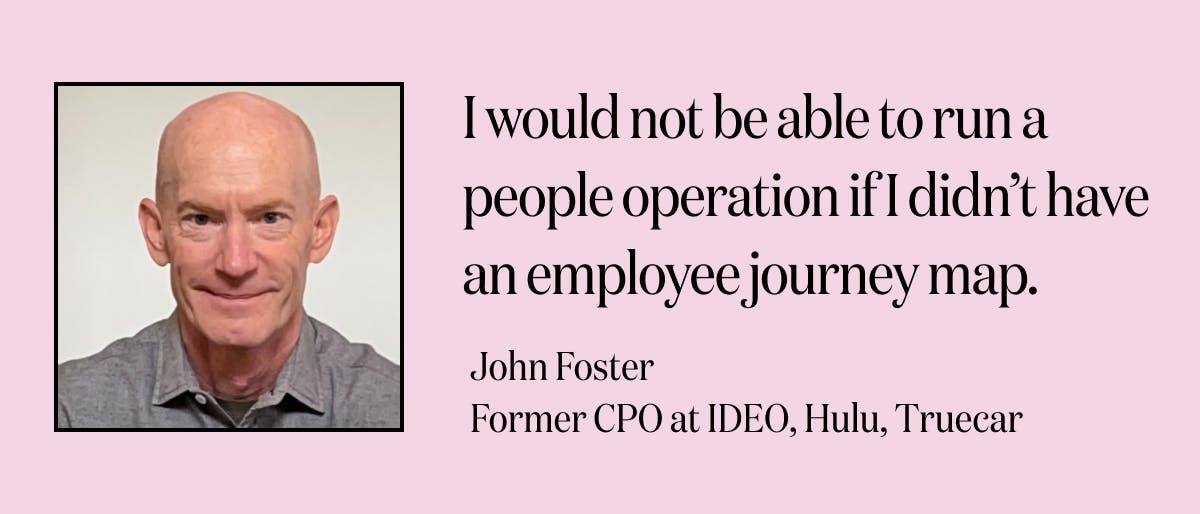
He explains that Journey Mapping is an essential first step, “When I start in a company - I introduce my team to the Journey Map in our first meeting.” He defines the People function around the idea that there is an employee journey and that designing and managing employee experiences is what the People function does.
“Employee Experience goes beyond the regular services HR that generally provides. With the journey map, we outline all the touch-points when an employee interacts with the company - and how they perceive those interactions. Once the journey map is complete, it's amazing! You can take a rookie new HR hire and say, this is how things work around here. Follow the map!" John adds.
How to create your employee journey map
Creating an Employee Journey Map from scratch may feel like a big project. And it would be, if you didn’t have any tools or resources to lean on. So, before diving into the steps on how to create your map, here are some tools you can use during this process:
- Use this Journey Map Visualisation when you first discuss the journey map with your team. It allows the team to understand the full journey and lets you review what’s already in place and what you may want to improve first.
- Use this Journey Mapping Worksheet when your team is ready to assess the work that needs to be done to improve the employee experience in your company. You can save and edit this worksheet over time.
- Pyn's soon-to-be-released Employee Journey Mapper will allow you to collaborate with your team to make your own Employee Journey Map. You can customize our Employee Journey Templates to make your own!
Now, let’s go through the five steps to create your journey map:
- Identify moments that matter in the employee journey (Moments)
- Have the right Touchpoints to provide support at each Moment (Coverage)
- Ensure your Touchpoints are aligned to company values and processes (Alignment)
- Personalize communications per employee persona (Personas)
- Decide when and how employees receive information or support (Distribution)
1. Identify moments that matter in the Employee Journey
Moments that matter are the touchpoints people encounter during their journey that have an outsized impact on the employee’s experience.
A positive experience during these moments may lift performance and engagement. A negative experience often has a long lasting negative impact on motivation and performance. So, it’s important to identify those moments and have the right communications in place to support an employee as they encounter a moment. Click here to read our article on moments that matter for more information.
Example of a newly promoted manager:
- In the manager journey, a moment is the day when a person is promoted to manager. The manager is hungry for information and clarity, and perhaps a bit nervous about managing their new relationship with their reports. They want to do well. If there is little or no information, clarity and support provided right at such a key moment, it will impact both motivation and performance.
The onboarding journey may be managed by People Operations, while the manager journey may be managed by L&D. Some companies hire a Head of Employee Experience who looks across the entire employee journey. To identify the moments that matter, you’ll want to invite representatives from relevant functions to indicate which moments of the journey they think matter most to employees.
2. Have the right Touchpoints to provide support at each Moment
For each moment that matters during the journey, you need to send employees communications that provide support.
Moments that matter are often moments of transition (e.g moving to a new team) or a moment that a manager or employee may not have a lot of experience with (e.g. parental leave) and therefore it is important to provide people with the clarity and support they need to successfully navigate them.
Pyn's Open Library includes over 200 employee communication templates for all the moments that matter. You can use them open source, and as a Pyn customer, you can automate these messages based on triggers set in your HRIS.
- Example of a newly promoted manager: Almost immediately after being promoted, the new manager will have 1:1 meetings. Therefore, communications in those first days should include a guide for the new manager on how to structure a kick-off 1:1 with their new direct reports.
3. Ensure your Touchpoints are aligned to company values and processes
Employee journeys don't occur in a vacuum - organizational context serves as the foundation on which an employee's experience is built.
Your company values and processes provide employees with the benchmark for how their journey may unfold. When the experience of employees aligns with what’s been promised through values and processes, it creates harmony.
While employees at different companies may experience the same moments in their journey, they will be guided towards different behaviors that align to the values and processes of their unique company experience.
A company that has specific values around Diversity will want to ensure that touchpoints related to moments like recruitment, company holidays and observances, and more include consistent recommendations to support Diversity efforts.
And a large public company may direct employees to stick closer to compliance processes than a smaller private team, affecting touchpoints related to moments like relocations, performance, or employee offboarding.
4. Personalize communications per employee persona
Two people experiencing the same moment require personalized communications based on their demographics. Instructions to a manager on how to put together a first week plan for a new hire will be different for a new hire in marketing vs engineering, or a contractor in Germany vs a permanent employee in Australia.
Example of a newly promoted manager: A new manager leading a team of engineers may be provided with specific instructions on how to access engineering managers’ resources and salary bands for engineers.
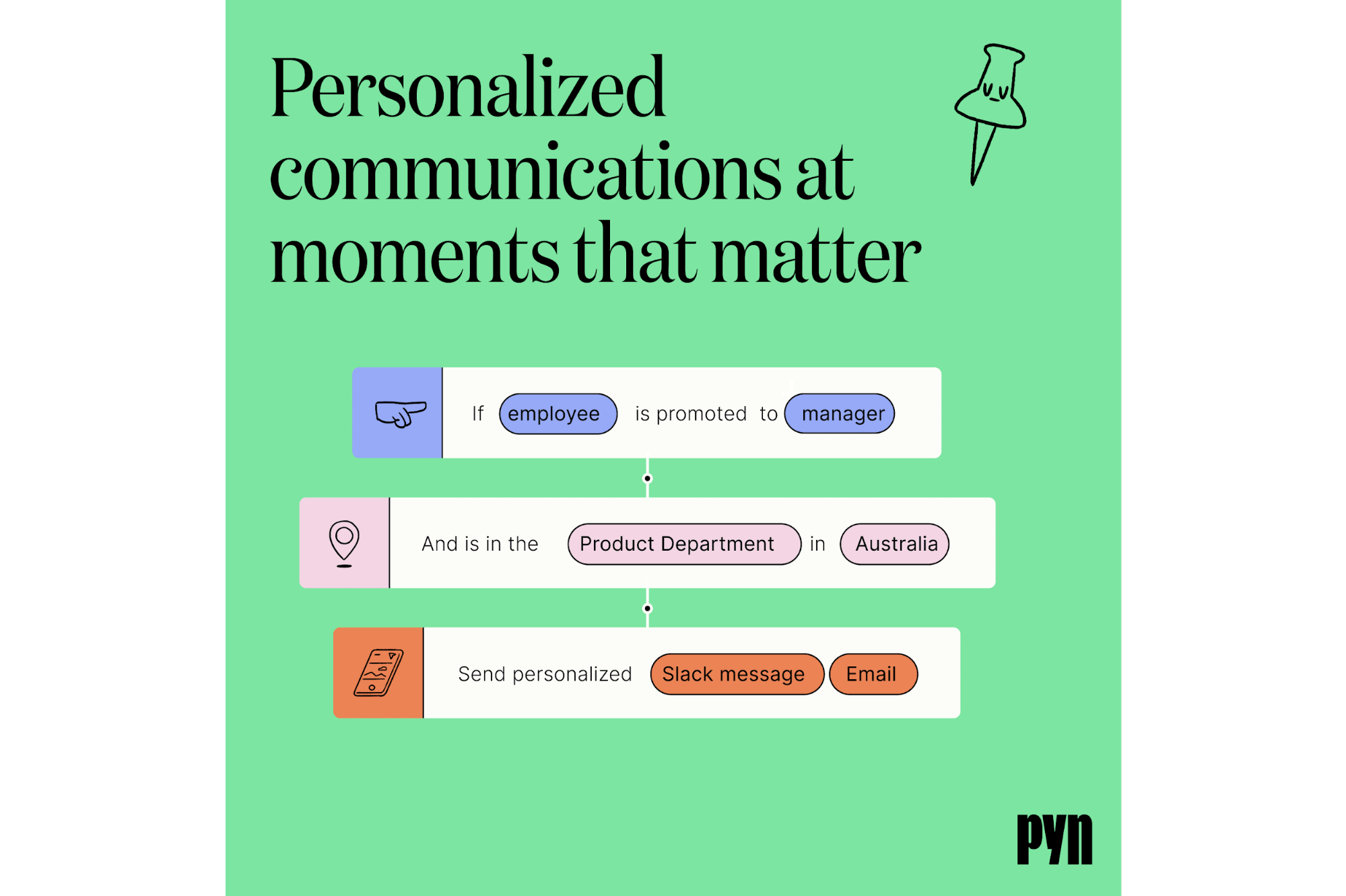
Four ways to personalize employee communications
1. Timing
Send communications to employees in-the-moment. An automated system like Pyn detects changes in someone’s employee data (like a promotion) or events associated with their profile (an upcoming holiday in their location) and delivers the message automatically at the right time.
2. Sender
Even when communications are automated across the employee journey, a system like Pyn can send Slacks or Emails on behalf of a person rather than a bot or system notification.
3. Personal information
Include key information like someone’s name, their managers name, dates, locations, job levels, or more. With Pyn, relevant data fields from your HRIS can be automatically inserted into a message.
4. Contextual information
Personalize communications based on an employee’s demographic information. For example, Pyn makes it easy to include a paragraph that is only visible to a person if they are in a certain team, or location, or job level.
5. Decide when and how employees receive information or support
A key step in operationalizing your Employee Journey Map, and the communications you put in place to support employees, is to consider how you will get information to the person who needs it.
You have two broad categories of communications:
- One-to-many: When a communication from one person is sent to many people. For example, an employee newsletter, all-company meetings, a Slack message in an all-hand channel.
- One-to-one: Communication between one person to another person. For example, manager to employees, HRBP to department leader, one-on-one meeting or follow up.
Both of these types of communications can occur either synchronously (in real time, like a live meeting) or asynchronously (not at the same time, like an email sent overnight).
In a company of 3,000 employees you will have hundreds of moments being experienced by people every week. There is a lot of information for employees to sift through to find what they need. On top of that, HR won’t always be able to track what happens for who, let alone to send those people the information they require manually.
Therefore it’s best to automate the sending of information and support across the employee journey so employees can get information and support when they need it.
Your employee journey map lists many predictable experiences of an employee, and with a platform like Pyn, you can automate what information or support to send at each touchpoint.

Prioritizing moments that matter
Here, we’ll further explore step one of building your Employee Journey Map: Identify moments that matter.
Every moment has an impact on the employee experience, so how do you choose where to start?
Do you start with employee onboarding since it’s important to make a good first impression? Or should you begin with supporting new managers because their impact affects many employees?
At the end of the day, what’s important is that you do start somewhere. You could pick a point on the employee journey that affects the most people and start there. It can be that simple.
However, there are many other factors to consider, if you want to.
In this section, we’ll present different frameworks for prioritizing the most impactful moments that matter on your Employee Journey Map. The goal is to help you make the biggest positive improvement to your employee experience in the shortest amount of time.
What are moments that matter?
Moments that matter are important events people encounter during their journey that have an outsized impact on the employee’s experience.
You can think about moments that matter across three dimensions: how they’ll impact the employee, their manager, and the company. There are often specific desired behaviors and outcomes for each group in a moment that matters.
These moments are often times of transition (e.g. becoming a manager) or an event that someone may be experiencing for the first time (e.g. parental leave). For these reasons, these moments require you to provide people with more support.
Four moments to prioritize on your Employee Journey Map
Remy Bleijendaal, Chief People Officer at data.ai, adds that it can be helpful to look at what’s most broken across your employee journey. “When I started at data.ia, we measured the whole experience and it was clear that we had a challenge in recruitment. We were taking too long to close roles, so that’s where we focused,” he explains.
You should review whatever internal data you have, like employee engagement surveys, headcount projections, turnover rates, etc. to help you select what will be most impactful based on where there are challenges.
There are some moments that are table stakes, says Remy. “You need a good baseline to start with,” he says. These moments need to be delivered otherwise your employees cannot grow.
We’ve outlined a few moments we see as a good baseline below, and our reasons why.
1. Onboarding
- All employees experience onboarding so it impacts the most people
- First impressions matter: “Employees who had effective onboarding feel up to 18x more commitment to their workplace,” according to BambooHR onboarding stats.
2. Life events
- Birthdays, work anniversaries, and parental leave are three key life events to cover.
- Milestones like anniversaries and birthdays are epiphany moments - natural occasions for reflection and often catalysts for life changes.
- Work anniversaries are a time when job-hunting activity tends to increase by as much as 9% (HBR research)
3. Becoming a manager
- New managers need additional support and training to do their best work.
- Managers impact others at your organization. At least 75% of voluntary turnover can be influenced by managers.
4. Career development
- While new hires and managers often get support, the ongoing development of your entire workforce is essential.
- Deloitte finds that companies with a strong learning culture are 92% more likely to develop novel products and processes, 52% more productive, 56% more likely to be the first to market with their products and services, and 17% more profitable than their peers.
Factor in your organization’s individual context
The frameworks we’ve outlined above are a good place to start for most organizations. This is because they typically happen within most organizations. New hires join, individual contributors are promoted to managers, work anniversaries occur.
That said, it’s important to factor in your organization’s individual context. If you’re not planning to hire many people, then don’t start with onboarding. If you’re planning to bring employees back to the office, then start with a return to office plan and communications.
Considering your organization’s individual context is also an important input into overall HR strategy planning. For example, when deciding where to focus on your Employee Journey Map, you may want to get the input of your CEO and other department leaders.
You could ask questions like:
- What are the company's top priorities right now?
- If you had two top priorities for the People function in the next 6 months, what would they be?
- Where is the People function adding the most value to the business (and where is it adding the least)?
- What do you think is the strongest asset of our culture (and where are we weaker)?
A group prioritization exercise for choosing moments
After you have listed your Moments that Matter, it’s time to prioritize your team work for the months, or year, ahead.
You may use one of several tools for your Journey Mapping. Whether you end up using physical or digital sticky notes or tools like Pyn’s Employee Journey Mapper.
Joris Luijke, Pyn's CEO and Cofounder shares fun and impactful way to plan your work. "Use an Effort/Impact Matrix to assess which of the Moments to upgrade first. Assign a Low/High score related to both Impact and Effort for each Moment then add them to the matrix pictured below."
Moments that are both “High Impact” and “Low Effort” may well be your low hanging fruits that you want to tackle this quarter!
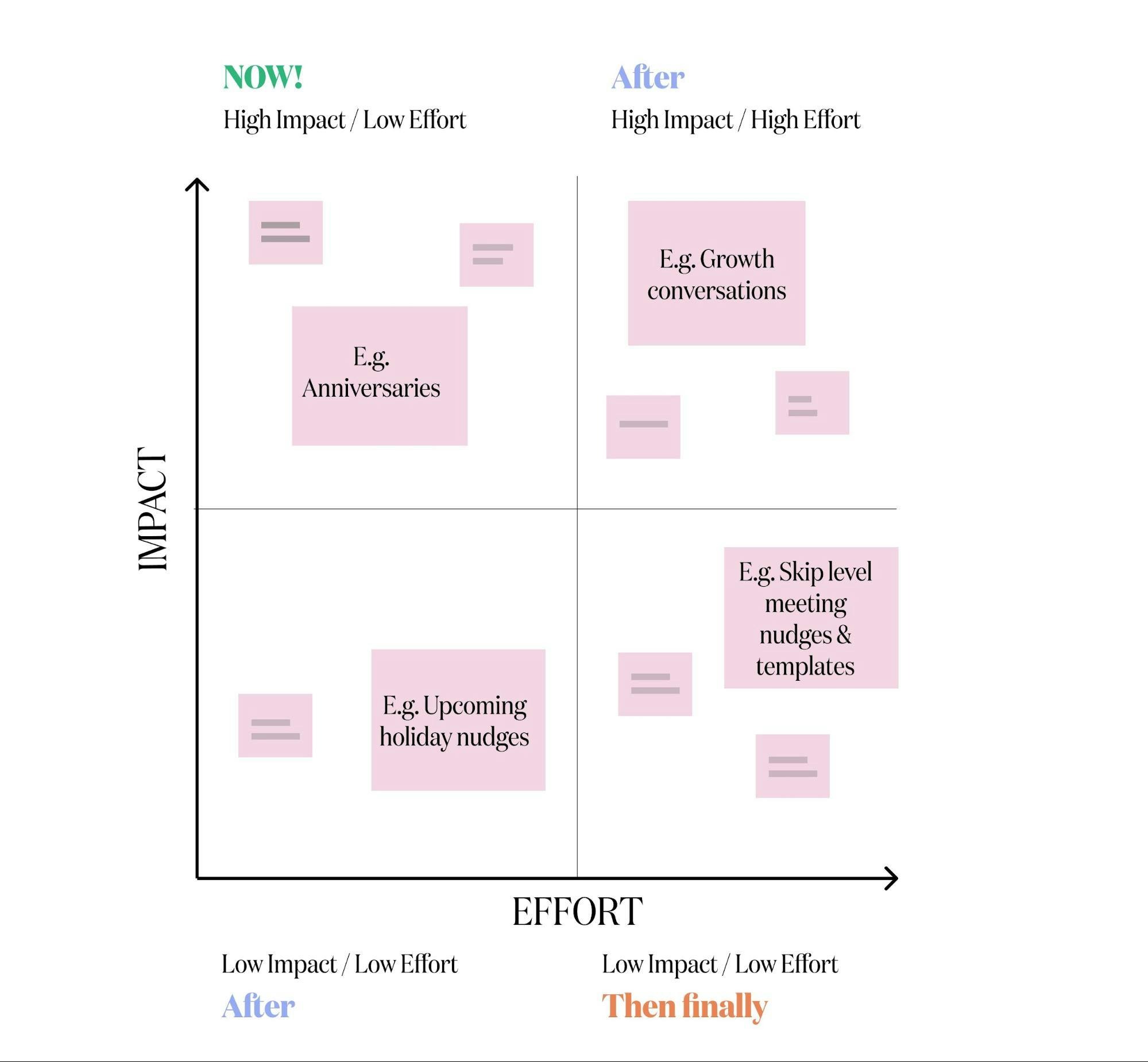

Strengthening Diversity, Equity, and Inclusion
DEI Consultant Natania Malin Gazek explores how your Employe Journey Map can be a powerful tool for moving the needle on diversity, equity, and inclusion
We’ll explore how the journey map development process can help you make your organization more diverse, equitable, and inclusive by helping you ensure you’re giving people equitable support across your organization.
Developing your Employee Journey Map is powerful for DEI progress because it gives you a clear process to ensure the employee journey works for people across diverse identities.
So how can you leverage this opportunity? Here are three ways we’ve found particularly effective.
1. Select a diverse group of stakeholders to engage in the EJM development process
Many of us have “go-to” people at work who we tend to bounce ideas off of or engage for feedback as we’re building out new projects. But when we keep going to the same people because we have pre-existing or strong relationships with them, we often miss crucial perspectives.
In the case of developing your Employee Journey Map, this impacts whose perspectives get built in – and whose don’t. The consequences of these decisions are big: the more diverse the group of stakeholders that we involve in the process of developing our EJM, the more diverse the group of employees the EJM will work for.
To solve this, look at the list of stakeholders you’ve identified to be involved in the EJM development process (check out our post on identifying your stakeholders and getting their buy-in for more) and ask yourself what groups are and aren’t represented on the list.
Some questions to consider as you review your stakeholders are:
- Which functional areas are and aren’t represented on the list? Do you have representatives from across each part of your HR team, like Talent Acquisition, Learning and Development, Business Partners, etc?
- Which departments are and aren’t represented on the list? Do you have folks from Operations? IT? Finance? Sales? Product?
- What levels of seniority are and aren’t represented on your list? Do you have individual contributors? Managers? C-Suite or Executive leaders?
- What demographic identities are and aren’t represented on the list? Do you have folks across genders, races, sexual orientations, (dis)ability status, age, religious affiliation, body size, family and caretaker status, etc?
If you notice you’re missing people from key areas, look at your org chart and figure out whose input makes sense to ask for as part of the development process. This will help you make sure your Employee Journey Map – and as a result your company culture – supports as diverse a group of people as possible.
2. Engage with your stakeholders in meaningful ways
When you ask your stakeholder group to be part of your EJM development process, it’s important to make sure you’re making good use of their time and not asking just for the sake of checking a box.
This means asking for feedback and information that you’ll actually use and apply. This will also allow you to build stronger relationships and partnerships with these stakeholders. How you do this depends on their areas of expertise. Here are some examples for each of the five steps of the EJM creation process:
- As you’re establishing your list of moments that matter for your first draft, make sure the stakeholders you’re working with have the information they need to contribute substantial ideas that leverage their areas of expertise. Then, ask your stakeholders to make sure the map reflects the moments that they see consistently mattering for staff on their team or in their department, or staff they’ve managed. You can add moments that they point out might be missing.
- When you’re working to determining the right touchpoints to provide support for each moment, you might share the Pyn open source library with your stakeholder group and ask them which communications would have been most helpful to them and their teams during their journeys.
- As you’re ensuring your touchpoints are aligned to company values and processes, you might ask your stakeholders what connections they see between the moments that have been most impactful in their personal journey at the company thus far and the company values and processes. If those moments aren’t yet reflected on the map or you haven’t made those connections yet, you can add them.
- When you personalize communications per employee persona, the diversity you established when forming your stakeholder group really comes in handy! Make sure your stakeholders know you particularly value their expertise because of the segments they represent, and that you want to make sure you’re taking into account the ways in which the communication could be personalized for their department, office location, tenure within the company, etc. (Note, when it comes to demographic identity, to make sure that you’re never asking one person to speak on behalf of their entire identity group! That’s textbook tokenization. Instead, reach out to paid subject matter experts to ensure your communications are culturally competent.)
- Finally, when you’re deciding when/how the employee gets the information/support, ask your stakeholders what communication modes would be most effective for them and their teams, and build those into your customization.
3: Create and use a default employee profile
As you design, you want to make sure that what you are designing is inclusive of your whole employee population. This must be done strategically and intentionally, and can be accomplished by creating a default employee profile.
Stacey Nordwall, Pyn’s Head of Employee Experience explains that, “A default employee profile helps you identify the communities within your organization that may currently be underserved or unsupported.”
You can access Pyn’s default employee profile to go through the following steps:
- Determine how the majority of your employees in a demographic identify (ex. most of your employees could be able-bodied).
- Decide if those people belong to a disadvantaged or marginalized group (ex. In your location, people who are able-bodied are not marginalized).
- Your default employee profile is then made up of demographics that apply to the communities within your organization that may currently be underserved or unsupported.
Once you’ve come up with your default employee profile based on demographics, you’ll answer a few questions to help you understand the challenges these groups may face.
“Developing this profile increases the likelihood that you will build an EJM that is more supportive for more employees. When you build to support your most marginalized communities first, you will by default design an experience that is more supportive for everyone,” says Stacey.
Using these three techniques strategically while developing your EJM can help your organization provide a more equitable employee experience, enabling you to sustainably grow a more demographically diverse team at all levels. Click here to learn about techniques for moving the needle on DEI while implementing the map you’ve created.

Supporting ongoing DEI work
Natania explains how ongoing use of the EJM helps you bolster your ongoing diversity, equity, and inclusion (DEI) work
Below, we outline three ways to use your Employee Journey map to support ongoing DEI work. The EJM implementation process can help you make your organization become more diverse, equitable, and inclusive by giving you a framework for providing more equitable support across your organization.
1. Diversify your leadership pipeline
It turns out that, across all demographic groups, we’re more likely to naturally provide support to people with whom we feel stronger connections – and because of evolutionary biology, we tend to feel stronger connections with people who we perceive as being similar to us.
This is part of why organizations become homogeneous and people in overrepresented groups are more likely to be promoted into leadership roles and stay in organizations longer. It’s also why so many organizations have difficulty meeting their DEI goals.
Your Employee Journey Map is a great tool to help avoid this problem because it gives you an equitable process to use to provide support to each person on your team. Managers in particular can benefit from this process. As you work with managers to support their teams, guide them towards relying on the EJM to determine when they reach out to their team members and how. When they do so, a few things will happen:
- First, if there are times we want to reach out to someone because we know it would be helpful, but that moment isn’t in the EJM, that’s a great flag! It could be useful to add it to the journey map so that we don’t forget to also reach out to other team members when they’re going through a similar situation.
- Conversely, if a manager isn’t as close with someone on their team, the EJM (and other automated communications that you can send to managers through Pyn) can be an excellent reminder for them that it’s time to reach out to that person so they get the support they need. This is a common need when a staff person is part of a marginalized group and they don’t share that identity with their direct manager.
In these ways, the EJM is an excellent tool for helping us mitigate the negative impacts of unconscious bias. It helps us interrupt the patterns that contribute to organizations becoming homogeneous in the first place.
Without an EJM – and other equitable systems and structures like it, including performance evaluation systems, salary bands and pay equity reviews, feedback routines, etc – people in overrepresented groups are more likely to be promoted into leadership roles and stay in organizations longer because they’re receiving stronger support than folks in marginalized groups.
With an EJM, we can make sure people are receiving strong support across demographic identities so that we’re promoting a more diverse group into leadership roles.
2. Proactively address areas of concern related to DEI
As you start using your Employee Journey Map more, you can pull data to notice what departments or types of employees are getting more or less support during their journeys, and intervening proactively.
If you see that certain departments, roles, levels of staff, or staff with specific demographic identities are sending or receiving more communications, and that those communications are causing lower turnover rates, higher performance ratings, and stronger achievement of OKRs, lift those up! You can share those as best practices across the organization so that everyone can better leverage your Employee Journey Map.
If you see that other departments, roles, levels of staff, or staff with specific demographic identities are sending or receiving fewer communications, you can intervene proactively so that they don’t start to see higher turnover and lower performance ratings as a result. So much better than waiting until you notice higher turnover and lower performance.
3. Get buy-in for DEI projects
As Stacey Nordwall, Head of Employee Experience at Pyn, points out, “There are two challenges most People Team Leaders will find themselves facing again and again: getting buy-in and getting budget.” As anyone who has tried to get buy-in and budget approved for DEI work knows, it’s no exception. The good news is, your Employee Journey Map can help.
Once you have your map built out, you can point to each moment that matters and talk about how DEI work is going to impact it. To figure out which moments are impacted by DEI in your company (hint: it’s probably most of them), you can work with a DEI subject matter expert (I’m happy to help!), or ask yourself questions like:
- Have we done any recent surveying to identify areas where demographic identity is negatively impacting staff experiences of equity and inclusion? If so, what moments are tied to those areas? What systems structures could we invest in building to ensure a more equitable and inclusive experience through those moments?
- Have we been getting feedback from any of our Affinity/Employe/Business Resource Groups or our DEI Council about areas where they’d like to see us make changes? If so, what moments are impacted by those areas?
- Have we made a statement or commitment related to DEI that we haven’t really followed through on? If we were to match our actions with our words to operationalize our commitment, what moments would be impacted?
Here's an example of a situation you may encounter:
- Perhaps your Employee Resource Groups have given you feedback that they’d like more transparent insight into how performance evaluations impact promotion decisions. Three ERGs have noted that some staff have insight into that and others don't’ – and that demographic identity seems to be a big factor in determining who is in which group. When making the case for implementing the ERGs’ recommendations, you can point to moments that matter within the EJM to show that investing in building out your performance evaluation and promotion frameworks to be more equitable would help you send clearer communications around these topics, and that would help you in specific moments within moments like onboarding, cyclical events, and exit.
This can be especially powerful for leaders who think of DEI as something that happens exclusively during recruiting, or exclusively during workshops. When working to secure their buy-in for more proactive, sustainable investment in DEI strategy work, the EJM provides a clear way to show how your DEI work impacts every stage of the employee lifecycle – and the moments with it.
Using these tools to thoughtfully and effectively implement your EJM can help your organization provide a more equitable employee experience, which makes it much easier to hire, engage, and retain diverse teams.
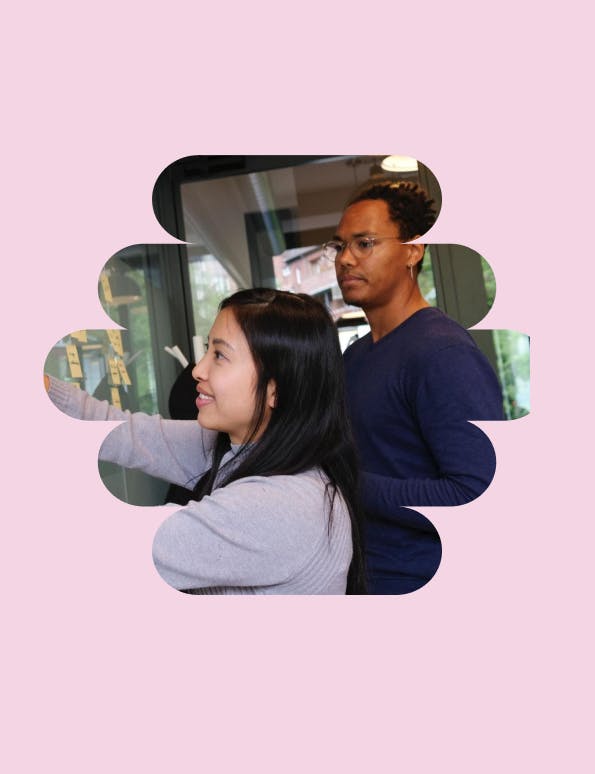
Designing your Employee Journey Map
While Pyn’s Employee Journey Mapper is in the works, our CEO Joris shares the tools he’s used while creating Employee Journey Maps so that you can make sure yours will be exceptional.
1. Pyn's Employee Journey Mapper
Aside from being fun and free-to-use, using Pyn will help make sure that no challenge in designing an optimal employee experience goes overlooked.
Pros
- The employee journey at-a-glance: Get touchpoints for every moment
- Collaborate, prioritize, and align strategy online!
- Easy to further automate and personalize support for employees
Scoring my Journey Mapping experience in Pyn: A+ (naturally 🙂 Sign up to see for yourself!)
2. Miro: Virtual Whiteboard
With Miro, your team can come together on an online canvas to craft a custom Journey Map. I personally had a great time designing mine - it was really enjoyable. Check it out here!
I did find myself spending quite some time on the design though, so that can slow the process down.
Pros
- Online, so distributed teams can access from anywhere
- Super easy to use and add (virtual) sticky notes when brainstorming
- It’s free (you can upgrade) and easy to set up
Cons
- No employee journey templates, so you’ll have to start from scratch
- Requires some consideration on how/where on the board you want your team’s input
- It’s hard to link to real content or systems
As a tool, I rate Miro super high (an A-grade tool). So, how would I score my experience creating a Journey Map using the tool? Scoring my Journey Mapping experience in Miro: C+
3. Figma: Online design tool
If you want more flexibility in your Journey map design, you can start collaborating in Figma. The collaboration options are similar to Miro, but allow you to build scalable more designs easily.
I created a Journey Map in Figma, and it was great to work in. I get a bit stuck when trying to add new moments or touch-points. Also, using the tool to prioritize and assign employee experience (EX) improvements is hard, so though the designs look great - you won’t be able to use Figma for project management.
Pros
- Online, so distributed teams can access from anywhere
- Can scale your designs and make your journey map look great
- Some solid templates in their template library to get you started
Cons
- Bit of a learning curve (their FigJam tool is easier)
- Hard to make changes to the designs (add moments or touch-points)
- It’s hard to move from Journey Map to activation (automating content etc)
Scoring my Journey Mapping experience in Figma: B-
4. Google Sheets: A list of moments
Working together on visuals can be a delightful challenge and an engaging experience, but sometimes the sheer power of mapping out your Employee Journey with all its Moments that Matter and touchpoints in one simple Google Sheet makes it more efficient to move forwards
towards action.
This powerful tool allows us to easily gather information while also helping plan what's needed for real EX improvements.
Without the visual representation Journey Map, navigating the list became a more difficult and disorienting task. It was challenging to keep sight of those high-level journeys and strategies.
Pros
- Very easy to add and change content
- Can prioritize and assign tasks
- Easy to collaborate and learn (many already use Google sheets every day)
Cons
- No visual of the Employee Journey
- Brainstorming and ideation feels stale
- Presenting your strategy to stakeholders using a sheet falls flat
Scoring my Journey Mapping experience in Google Sheets: C+
5. Notion: Collaboration platform
Sometimes it’s just easier to add all your work in the collaboration platforms you already use. If you work in a platform like Notion, you could decide to design your Employee Journey Map there.
Notion’s “Boards” features make it easy to structure your Journey and invite team members to suggest more touchpoints using “Cards.” It is also nice to see different views of the employee journey based on different criteria (using tags I added) and then filtering. For example, if I wanted to view all touchpoints I had tagged to be “owned by Learning & Development”
I felt it was easy to structure parts of the journey but I found myself having to create different pages for different parts (or categories) within the journey.
Even if I could probably have found a work-around, Notion is simply not designed to really scale your Journey map to the (almost infinite) size you’d require.
Pros
- If you already use Notion, it’s easy for team members (and yourself) to use
- Can prioritize and assign tasks and filter the journey map based on criteria/tags
- Adding touch points using the “Cards” is a nice, playful, experience
Cons
- Notion struggles with a longer journey like the employee journey
- The map gets a bit messy (too many tags etc) and therefore loses its power
- Hard to make the next step of automating and personalizing support for employees
Scoring my Journey Mapping experience in Notion: B-
6. Whiteboard and Post-Its
Having the team together face-to-face and creating your journey map is priceless.
It’s such a fun activity! And it will be very effective - up to a certain point. I found that, unless you have endless time and all stakeholders in the room, you’ll probably be running multiple sessions.
Therefore running the exercise face-to-face often provides a great starting point. And you’ll need to schedule more work to make the work worthwhile. Unfortunately, that is hard to do without software.
I also found it hard to have the team start with a blank slate (or whiteboard). It’s more helpful to begin Journey Mapping equipped with readymade templates that broadly lay out what should be considered during employee journeys upfront - avoiding having everyone start from scratch on their whiteboard.
Pros
- Very energizing and collaborative
- Easier to educate the team on the benefits of journey mapping at the same time
- Easier to ensure everyone gets involved
Cons
- Harder to move from whiteboard to action
- Hard to start with a blank slate
- Hard to allocate enough time and get all stakeholders involved
Scoring my Journey Mapping experience on the whiteboard with stickies: B
My report card scores for all systems
There’s no one right way to get started with Employee Journey Mapping, but we know that our new tool will help you get things off the ground faster.
My report card on the Journey Mapping experience:
- Pyn Employee Journey Mapper: A+
- in Miro: C+
- In Figma: B-
- In Google Sheets: C+
- In Notion: B-
- On whiteboard with stickies: B
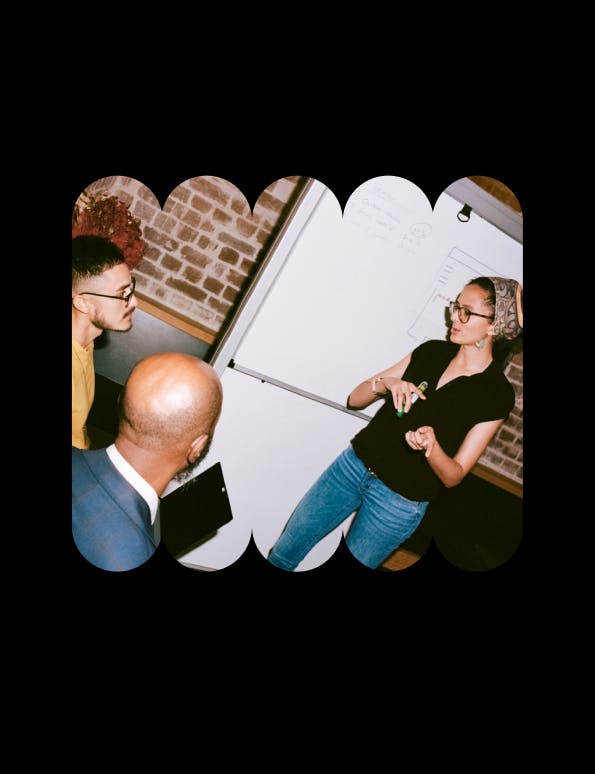
Getting stakeholder buy-in
Advice from People Leaders on how to identify your key stakeholders and get their buy-in.
When you’re excited about a new tool or process, you want to be able to run with it. But then you remember - if this is going to be effective, I need to get stakeholder buy-in.
HR and People Teams don’t work in a vacuum. Quite the opposite, they’re one of the teams that gets the most critique (solicited or otherwise…) on how they’re working or what their perceived accomplishments are.
Thankfully, we have some great advice from People Leaders who have been down this road before.
An overview of securing stakeholder buy-in
A stakeholder is a person at your company that will be asked to use or manage your project. In this context, that means anyone who would use or manage your new Employee Journey Map.
You could expand this to include secondary stakeholders, which would be anyone that you would be asking to interact with the Employee Journey Map.
Primary Stakeholders
Before finalizing your map, you should identify your main stakeholders, put together clear messaging on what you will communicate to them, and decide when to bring them into the process. For example, you’ll probably want to involve those who will be asked to collaborate in building or managing the Employee Journey Map ahead of those who would be using it as a reference.
Next, meet with your stakeholders and capture their feedback. What questions or concerns do they have? Be sure you get back to them with answers. This demonstrates that you’re willing to make the Employee Journey Map work not just for you, but for everyone.
What to present to each stakeholder
John Foster says that creating different versions or views of your Employee Journey Map can help with getting stakeholder buy-in.
“It's like the specifications of building a house,” he explains, “Only a few people know all the details, but they've got a plumbing plan, an electrical plan, a framing plan, all the different parts are broken out. This way, that particular element is really obvious to the people that are working on it.” You can do the same for your stakeholders meetings by bringing or highlighting the elements that matter most for them.
Stakeholders within the HR team
Within your HR or People Team, you might have Operations, Talent Acquisition, Business Partners, Learning and Development, or more. The point is, there are many stakeholders within your team and they’re a good place to start when it comes to getting buy-in.
Felicitas Schweiker gives this advice, “Involve your team. They are the creators of the map - whether you have a map or not, they're delivering on moments, they're creating moments, maybe you don't even know what moments they're working on.” She suggests bringing them together in a small workshop to get started, and having everyone list the moments they work on day-to-day.
“All of the different disciplines within your HR team are stakeholders, and oftentimes they are disconnected from each other. This may be because of the software they're using or other silos they're in. So immediately I get my whole team together and show them how we all share parts of the journey,” adds John.
He uses the Employee Journey Map as a motivational tool to get everyone working together. “There's nothing more annoying to me as a leader than to have people passing things over a fence as if somebody was on the other side, and they didn't know what was happening next,” he explains.
It becomes a particularly helpful tool for junior employees on your team who may not have looked at an entire employee journey. John adds,
“We build empathy for the employee right off the bat by just getting the whole team to see the whole employee journey.”
John Foster
4X CPO
Core collaborators: Managers
While all of your employees will be affected by how you map out the employee journey, your managers will be more involved in shaping it. Involving them as a stakeholder once you have a version of your Journey Map that is ready to be shared, helps them understand the scale of their impact on the employee experience.
“In terms of getting managers on board, the best way is to have a journey mapping session with them, so they're collaborators in building it. Oftentimes they can feel like they're left out of the loop because they're not themselves focusing on the full employee experience all the time. And so to see where they play a part and how they're part of a team for the journey is really an interesting process,” says John.
Executive sponsorship
Starting a new project without executive buy-in is tough. But when you do have it, it makes the entire implementation that much easier. That’s why our goal here is not just buy-in, but sponsorship.
John explains, “When going to the CFO, CEO or COO to get budget or talk about annual spending or annual projects, I use an Employee Journey Map to help them understand where and why we want to do the things we want to do and how they fit together.”
Having the Employee Journey Map as a visualization of your HR strategy can make a compelling case to executives. “It can be hard sometimes in HR to measure progress, but the Employee Journey Map helps you do that,” says Joris Luijke, CEO of Pyn.
“It can be hard sometimes in HR to measure progress, but the Employee Journey Map helps you do that.”
Joris Luijke
CEO and Cofounder of Pyn
Gatekeepers: IT, Finance, and Payroll
IT, Finance, and Payroll can be stakeholders and they can also be gatekeepers. They may control access to what new software can be implemented, or how much a team can spend on a new tool or implementation.
In both respects, they’re critical to the success of the Employee Journey Mapping process. John’s advice is to present the Employee Journey Map to showcase, “We're both touching the same moment at the same time and we're together on a team trying to help that moment happen.”
The good news is that Pyn’s new Employee Journey Mapping tool is free to use, so you won’t need to worry about budget. Our tool lets you easily collaborate with members of your team, and present to different stakeholders across your organization.

Keeping your map alive and active
When getting started with a new initiative, the last thing you want is for all of your hard work to disappear in a few months….or weeks.
Keeping your Employee Journey Map relevant on your HR team and across departments doesn’t have to be a struggle. This section provides expert advice on how to keep your Employee Journey Map alive and active.
Collaborate on your employee journey map
Getting buy-in on a new process like employee journey mapping is easier when you have other people on board. Collaborating on your employee journey map with your team is the first step to keeping it an active tool.
“In my staff meetings I use an evaluation of our Employee Journey Map as a monthly team building activity. The team knows this is a document we use on a regular basis to evaluate what we're doing,” explains John. The more you refer back to the Employee Journey Map when working and planning with your team, the more it becomes an active tool in your HR strategy.
Use your employee journey map during HR strategy offsites
During your offsite, your Employee Journey Map is key to helping your team understand the gaps in your employee experience. Review your map to see where you have coverage and where there is room for improvement.
When planning for the outcomes of your HR offsite, think about how you’ll use your map to represent the work you have planned, like using a red/yellow/green status for priority on what’s next.
Review your employee journey map in quarterly planning meetings
For example, let’s say you’ve started out with improving employee onboarding, since it’s an employee’s first touchpoint with your company. You’ve mapped out what messages need to be sent, and set up an onboarding buddy program. Now, in the next quarter, your plan is to build in more support for first time managers.
On your Employee Journey Map you can visualize both the progress you’ve made and what’s next for your team. This is useful both in team meetings and as a presentation tool for cross-team collaboration and reporting to management or the C-suite.
Display your employee journey map in-person or online
If your company is co-located, printing a quarterly version of your Employee Journey Map and displaying it in a high-traffic area is a great way to make it an active tool within your company.
If you’re not co-located, you could share your Employee Journey Map visualization on your company’s intranet, or even hold regular feedback sessions where employees are invited to explore the Journey Map with you and provide their input.

Your map and budgeting
Pyn’s Head of Employee Experience, Stacey Nordwall, provides guidance in this section on how you can use your Employee Journey Map to make the case for budget.
There are two challenges most People Team Leaders will find themselves facing again and again: getting buy-in and getting budget.
Review current and previous annual costs
As you start your budgeting process, the first step is to review the actual costs for the current and previous years to see what you can learn and where you can adjust.
Be sure to note any factors that might have caused you to be over or under budget. It’s also a good time to review HR metrics such as turnover, engagement, or offer acceptance rate to identify where you may need to invest in the years ahead.
Additionally, reflect on how effectively your current processes, programs, and technologies are working for you. For example, if you notice low utilization of programs, numerous manual tasks that could be automated, or that the workarounds in your tech stack are no longer working for you, you may want to update your allocations in these areas. Review with your team if the current state is providing you enough value, if it is supportive of the employee experience, and if it can appropriately scale with your team.
Gather information about changes for the next year
For the upcoming year, you’ll want to gather as much information as possible about changes you can anticipate and build into your budget, such as:
- Projected headcount (particularly executive level hires)
- Projected turnover
- Benefits cost increases
- Salary increases
- Expansion to other locations
- Expected travel (particularly company offsites)
- Changes in laws or regulations that may impact your organization
You can bring the information you have gathered about where you are and where you’re going into your strategy and budget planning session along with your Employee Journey Map. The Employee Journey Map is a visualization of the employee experience from recruitment to becoming an alumni that helps define and prioritize the work that your team needs to do in order to better support employees and the business.
Using all of this information in tandem with the Employee Journey Map helps you identify potential gaps in the employee experience that may need to be filled, including new benefits, programs, or policies that may need to be added. In the case of scaling companies, it also helps you plan for how you’ll need to build your team and its tech over the next 12-24 months in order to provide the necessary infrastructure to support employees.
Tie your budget ask to improvements demonstrated on your map
Bringing the Employee Journey Map into your budgeting and planning process allows you to create context. It gives you the opportunity to tell your stakeholders a compelling story. The Employee Journey Map enables you to holistically visualize the employee experience and identify areas for improvement, while tying it to budgeting helps demonstrate the value of investing in your team and technology.
Here are two examples from Remy Bleijendaal, Chief People Officer at data.ai:
“Let’s say you have five AE roles open and it takes you 90 days to fill them. Each carries a revenue goal of X amount of dollars. If you speed up the hiring by one month, you have less seats open, and can immediately measure the impact on revenue. Or you could look at attrition, how much does it cost? Let's say first year attrition. First year, most of the people are not really adding that much value. How much does it cost then to ax the person? How much does it cost to hire the person? How much does it cost to ramp this person before they become effective? And you have a really important indicator of how much business results you're making.”
The Employee Journey Map not only helps you plan your HR strategy, it helps connect the dots between what you are asking for and how you will deliver it. Using it you are able to tell the story of the employee experience you want to create, explain the value that experience unlocks for the business (through improved employee experience, engagement, retention and tenure), and demonstrate that the resources you’re requesting are needed to deliver that value.
By presenting a comprehensive plan, communicating effectively, and showing the ROI, you can increase your chances of getting the support and resources you need to create a positive employee experience and drive business success.

The MVP of an Employee Journey Map
Creating an Employee Journey Map is a strategic method of designing an equitable and world-class employee experience. But it can be a daunting exercise, particularly if you are starting from scratch. However, you don’t have to build out the entire journey all at once to start making a significant impact - and there are tools to help!
Pyn's Employee Journey Mapper makes it easy to create a unique and remarkable employee experience by providing template maps for you to start with.
In this section, Pyn’s Head of Employee Experience, Stacey Nordwall, shares what it takes to get to an MVP of your Employee Journey Map, based on her experience creating template journeys that will be available in Pyn’s Employee Journey Mapper.
How to get started on your MVP
A minimum viable product (MVP), is a product with sufficient features that is able to attract early adopters. In the case of an Employee Journey Map, your MVP should be a version of your map with sufficient detail to function as a useful tool for your team (and help you get buy-in from others).
Getting started can be anything from assembling your team in a room with a whiteboard and sticky notes to using a design tool for virtual asynchronous collaboration. Identify the tools available to your team and pick what works best based on how you collaborate with one another.
Next, reflect on what is currently happening or will happen within the next year within the business. Are you hiring and onboarding regularly? Will you be promoting a lot of first-time managers? Do you know folks who will go on parental leave? Have you been experiencing low engagement of employees at a certain tenure?
Jot down all the high-level moments that you expect your employees to experience over the next year. This is your first draft journey map.
Then ask yourselves - Does support for any of these moments currently exist? Is it time to update anything?
Use these observations to start small. Focus on what you believe will be the highest impact moment within your company and begin building out your employee journey map around that moment.
Remy Bleijendaal, Chief People Officer at data.ai explains it this way, “Instead of going for something perfect, start with something small, get going.” Then, once you have your MVP, you can iterate from there.
An MVP for every company size
At early-stage or small companies with HR teams-of-one or smaller teams, you may need to begin by focusing on the big-ticket moments that every employee will experience. This usually means starting with onboarding and offboarding. If you can, add life events such as birthdays, work anniversaries, and parental leave, to also cover those important employee milestones.
At a mid-sized company with slightly bigger HR teams, you may want to focus on further building out onboarding, by including onboarding buddies and more extensive 90-day plans, as well as building out your first-time manager moments. It’s also important to design your employee journey map to include performance and feedback cycles.
At a larger company, create an employee journey map that includes ongoing manager development and career development, as well as moments that focus on continuing to engage more tenured employees.
Keep the momentum going
As you continue to build your employee experience, return to the employee journey map to chart the progress you’ve made and decide what’s next. To keep your Employee Journey Map alive and active, Joris Luijke, CEO and co-founder of Pyn recommends revisiting your map on a regular basis, like in quarterly reviews and annual planning meetings, to ensure you’re prioritizing what’s most important next.
Use the journey map your team has created to engage employees. Show them what the employee journey at your company looks like and how they are being supported across different impactful moments. Ask for their feedback on the map - this way they feel that they are co-creating the employee experience at the company.
The moment before you decide to start a project is often the most overwhelming. It can be hard to know where to begin and the work ahead can feel massive. But, luckily, by reading this guide, you’ve already made the first move!
